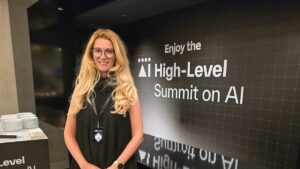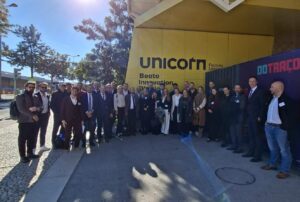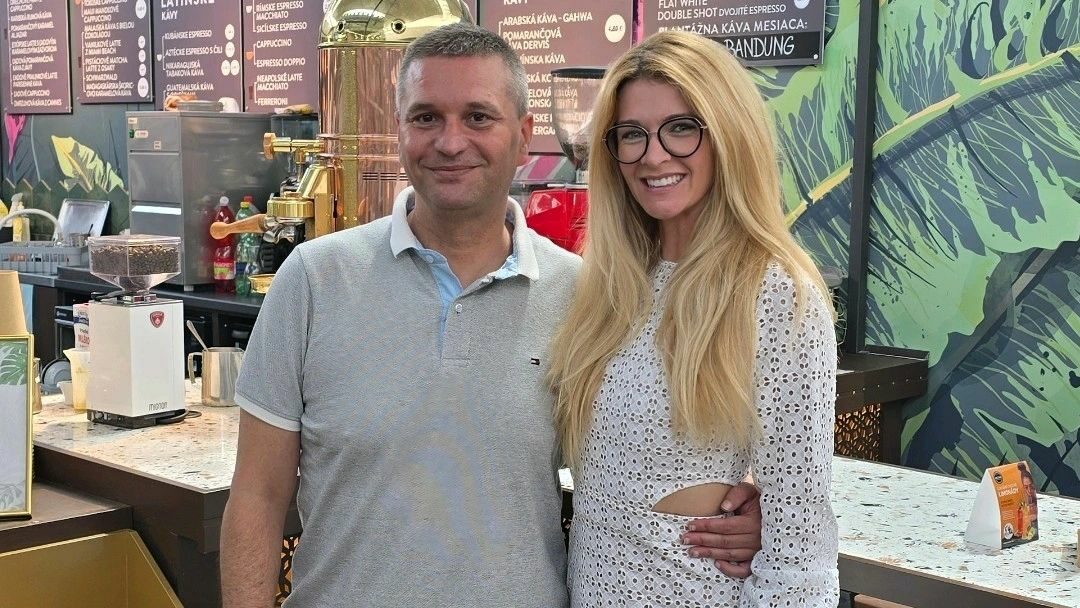When Technology Meets Inclusion: A Vision for a Fair Society
In recent days, an inspiring meeting took place between Lucia Maličková, project manager at the National Supercomputing Center and the National Competence Centre for High-Performance Computing (HPC), and Ján Bihari, visionary, founder of Tibi Digital, and thought leader in the field of Roma community digitalization.
The meeting was marked by themes of inclusion, openness, and a shared vision of a digital future that leaves no one behind.In the beginning was the Word. And if the future is to belong to everyone, it too must begin with the Word,”echoed during the conversations that went beyond the realm of technology and touched upon the very essence of what a 21st-century society should look like.
Lucia Maličková has long worked at the intersection of technological innovation and societal benefit. In her role at the National Competence Centre for HPC, she focuses on connecting Slovak research institutions, companies, and the public sector with the opportunities offered by supercomputing and artificial intelligence. Her goal is to ensure that high-performance computing is not the privilege of a narrow group of experts, but a tool that serves people – in science, industry, and social innovation.
Ján Bihari, founder of Tibi Digital, is a long-standing activist and expert in bridging the digital divide. With passion and dedication, he develops educational and technological tools aimed at the Roma community – particularly through language, gaming, and artificial intelligence. In his projects, he collaborates with Roma user experience testers, connecting cutting-edge development with authentic life experiences and real community needs.
Together, they explored ways to connect high-performance computing, artificial intelligence, and digital inclusion. Their discussions focused on the possibilities of creating inclusive digital tools that could serve marginalized communities – not merely as a form of assistance, but as a genuine means of empowerment and participation in the digital economy.
Their shared vision is rooted in the belief that technological progress must go hand in hand with social responsibility. Both Maličková and Bihari see meaning in connecting technology with real human stories – in places where artificial intelligence and supercomputing can help bridge divides, level the playing field, and turn prejudice into opportunity.
Bihari’s approach is grounded in a deep belief that technology holds the potential to bring about equality – if harnessed correctly. He develops applications that respond to demographic challenges, such as population aging, while simultaneously creating opportunities for Roma women in the field of caregiving.
Lucia Maličková praised his work as clear evidence that innovation can—and must—be inclusive if it is to have a real and lasting impact.
“We look forward to future collaboration. Because technological progress only truly matters when it is accessible to everyone – and when it transforms lives for the better. Inclusion is not just a goal; it is a fundamental prerequisite for a just society.“
 We Participated in the High-Level Summit on AI in Bratislava 2 Dec - Pozývame vás na odbornú online prednášku „Building Europe’s Sovereign AI – The Bielik.AI Case“, ktorá sa uskutoční 11. decembra 2025 o 10:00. Podujatie je určené pre odbornú komunitu aj širokú verejnosť so záujmom o umelú inteligenciu, európsku technologickú suverenitu a otvorené AI iniciatívy.
We Participated in the High-Level Summit on AI in Bratislava 2 Dec - Pozývame vás na odbornú online prednášku „Building Europe’s Sovereign AI – The Bielik.AI Case“, ktorá sa uskutoční 11. decembra 2025 o 10:00. Podujatie je určené pre odbornú komunitu aj širokú verejnosť so záujmom o umelú inteligenciu, európsku technologickú suverenitu a otvorené AI iniciatívy. NCC Slovakia on Business Mission in Portugal During the State Visit of the Slovak President 2 Dec - On 26–27 November 2025, the National Supercomputing Centre (NSCC Slovakia) took part in a business mission to Portugal held on the occasion of the state visit of the President of the Slovak Republic, Peter Pellegrini. Božidara Pellegrini took part in the mission on behalf of NSCC and also served as the representative of the National Competence Centre for HPC (NCC Slovakia) – the NSCC division responsible for the EuroCC project and for facilitating access of Slovak stakeholders to EuroHPC JU supercomputing resources. The delegation consisted of nearly 20 innovative Slovak companies and institutions active in the fields of digital solutions, information technologies, smart cities, and energy.
NCC Slovakia on Business Mission in Portugal During the State Visit of the Slovak President 2 Dec - On 26–27 November 2025, the National Supercomputing Centre (NSCC Slovakia) took part in a business mission to Portugal held on the occasion of the state visit of the President of the Slovak Republic, Peter Pellegrini. Božidara Pellegrini took part in the mission on behalf of NSCC and also served as the representative of the National Competence Centre for HPC (NCC Slovakia) – the NSCC division responsible for the EuroCC project and for facilitating access of Slovak stakeholders to EuroHPC JU supercomputing resources. The delegation consisted of nearly 20 innovative Slovak companies and institutions active in the fields of digital solutions, information technologies, smart cities, and energy. Invitation to the Online Lecture: Building Europe’s Sovereign AI – The Bielik.AI Case 24 Nov - Pozývame vás na odbornú online prednášku „Building Europe’s Sovereign AI – The Bielik.AI Case“, ktorá sa uskutoční 11. decembra 2025 o 10:00. Podujatie je určené pre odbornú komunitu aj širokú verejnosť so záujmom o umelú inteligenciu, európsku technologickú suverenitu a otvorené AI iniciatívy.
Invitation to the Online Lecture: Building Europe’s Sovereign AI – The Bielik.AI Case 24 Nov - Pozývame vás na odbornú online prednášku „Building Europe’s Sovereign AI – The Bielik.AI Case“, ktorá sa uskutoční 11. decembra 2025 o 10:00. Podujatie je určené pre odbornú komunitu aj širokú verejnosť so záujmom o umelú inteligenciu, európsku technologickú suverenitu a otvorené AI iniciatívy.
